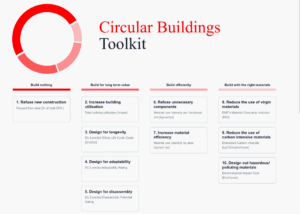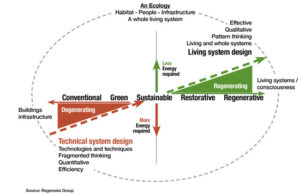Over the past two weeks, I have focused my attention on understanding passive building design and the concept of circularity. Biomimicry promotes the development of replacing our current linear waste streams with sustainable and circular models. The construction industry represents one of the most unsustainable and linear systems. It is responsible for roughly half of the raw material extraction and generates an estimated third of the world’s overall waste, and at least 40% of the world’s carbon dioxide emissions [BBC]. It is this conventional anthropocentric building model that motivated me to pair the concepts of circularity with sustainable construction. I have gathered diverse insights from various stakeholders including:
- Arup, a building design firm headquartered in London
- Van Asselt, Assistant Professor of Mechanical Engineering at Lafayette College
- Almeida, D.Eng. LEED Green Associate and Visiting Assistant Professor for Lafayette Civil and Environmental Engineering
- Michael Reynolds, “Earthship” passive solar house architect
Each entity, whether company or person, individually works to promote more sustainable construction practices. Though they do not use the term “biomimicry” per se, they each have done an abundance of research on different components of passive design and its influence on society. The different perspectives helped me to develop a stronger understanding of the construction industry, passive design, and circularity. For reference, “passive design” refers to the practice of designing buildings to be functional by utilizing natural resources (the sun, greenery, plantings, thermal mass) and materials instead of active mechanical systems (large AC units, artificial lights). I will share my notes and interpretations from these discussions below. These notes will be separated into two blog posts with the first (this one) focusing on Arup’s panel discussion on circularity and the second addressing my conversations with Prof. Van Asselt, Prof. Almeida, and Michael Reynolds.
Arup Panel Discussion Notes: Arup Circular Building Toolkit
As a senior, I have been job searching for firms and organizations that centralize sustainability and justice in everything that they do. A friend who is a mechanical engineer for Arup, recommended I investigate Arup for a potential job. As it says on the company’s website, “Arup’s primary goal is to develop a truly sustainable built environment.” They identify that humans must function within the capacity of the environment, and currently, we are exceeding those boundaries at alarming rates. With a wide-reaching impact as an international firm working across 140 countries, Arup is committed to developing more sustainable buildings and construction practices. One way they have attempted to do this is through the development of a “Circular Building Toolkit” that can be applied universally. This toolkit was created in collaboration with the Ellen MacArthur Foundation, a charity committed to the generation of a circular economy that eliminates waste and pollution. The circular building model is designed to promote the circular economy with three objectives:
construction practices. One way they have attempted to do this is through the development of a “Circular Building Toolkit” that can be applied universally. This toolkit was created in collaboration with the Ellen MacArthur Foundation, a charity committed to the generation of a circular economy that eliminates waste and pollution. The circular building model is designed to promote the circular economy with three objectives:
- Technical and practical guidelines that are engaging and accessible.
- Outcomes aligned with external policy contexts
- A framework for innovation and positive impact that encourages stakeholders to cross the value train.
Arup identifies that we are currently in a conventional building model and that we ultimately should strive to reach a regenerative design model. However, to reach this level we must overcome the steppingstone of green, sustainable, and restorative design models (see image below). The green design model is the first step and something that Arup believes will be easily reachable with the utilization of the circular building design toolkit. By creating a toolkit that is adaptable to different contexts and giving free access to resources such as this panel discussion posted on YouTube, Arup supports accessibility and education.
Following an introduction to the design toolkit and how to access it on the Arup website, the moderator of the talk, Eva Hinkers- the Europe Region Chair of Arup, asked panelists questions about their expertise in creating more sustainable systems.
The first panelist, Adam Elman, is the head of sustainability at Google. He talked about the “essential role” that digital tools and technology play in addressing the climate crisis. Some of these technologies include building information modeling and AI used to create digital buildings that highlight energy usage and capacity throughout the structure. They also use technologies to identify food waste to influence corporate and consumer decisions. This feature is used in Google headquarters’ cafe. According to Adam Elman, Google looks at topics of sustainability in its technology in 3 ways: in terms of its own operations, how supporting partners and stakeholders can use the technology, and how it enables everyone to take part in sustainability data collection.
The second panelist, Paul King, is the MD of Sustainability & Social Impact at Lendlease Europe. He spoke about the importance of the circular economy and building model in the real estate industry. He noted the way industries are often guilty of thinking of aspects of sustainability in different sectors, but it is important to recognize that all aspects of sustainability are interconnected. This mindset has shifted with the pandemic which has helped us to think differently and consider how to build and implement practices in the present that will be beneficial to our future. He called on the importance of designing for the future that considers environmental impacts as a guiding principle for design. “Many more companies have joined into the sustainable built environment; however, we need to go beyond what we are currently doing to make effective change”, according to Paul King. “We need to go beyond net-zero- most buildings can fairly easily address Scope I and Scope II emissions, but Scope III are the ones we also have to consider. We must rethink the way we design buildings from materials to assembly. We need to work towards designing buildings with low carbon materials and in a way that buildings are able to be assembled and disassembled to eradicate waste.”
The third panelist, Philipp Horn, is the head of the EIB Circular Economy Division for the Environmental & Natural Resources Department at the European Investment Bank (EIB). From an economic perspective, Phillip Horn recognized the circular building toolkit as supporting the financial drive to participate in circular design models. He mentioned that the EIB is committed to achieving the UN Sustainable Development Goals, but to achieve them, society must work towards a circular economy. He noted that the taxonomy for sustainable financing is on its way which serves as another indication of the importance of circularity. He recommends any construction project consider the aspect of circularity of design. He notes that temporary sustainable initiatives become permanent uses because it is so essential to the way we live today. This example reminded me of how the outdoor pop-up stands for stores in Downtown Easton have become permanent and now the road is blocked off to allow outdoor social and market spaces. The flexibility and adaptability of the built environment are key to implementing circular models.
Finally, the fourth panelist, Permille Berg, is the Science Director at BLOXHUB, a nordic hub for sustainable urbanization. Permille Berg noted that mindset, knowledge, and empowerment are some of the key drivers for change across all systems. She talked about the need for systemic change which can only be achieved with partnerships and referenced the value of this panel discussion that brought together people from different sectors to speak about a common purpose. Berg noted that the current focus on scarcity of resources and a sense of urgency is bringing us together and assisting with risk aversion.
It was interesting to hear professionals from many different sectors- technology, real estate, financial services, and urban development speak about how their specific focus areas will be benefited from a circular economy and building model. But, the biggest takeaway, I would argue, was the need for interdisciplinary partnerships to have any success in creating a more sustainable and circular future. With the construction industry being the third-largest contributor to waste it is vital that lots of attention and effort are given to reducing this waste. And perhaps more importantly, this reduction is arrived at through a community effort that recognizes human development is only a small piece in this greater system. Finding a balance between human development, sustainable design, and green space will be a challenge worth working through for all areas of our society to thrive. The Circular Building Toolkit is designed to be accessible and a basis for education gives me hope that such conservative energy may adjust to the urgent need for sustainable change. In part 2 of this blog post, other perspectives will be explored to provide more context for this issue.
References:
- “The industry creating a third of the world’s waste” by BBC (2021) article: https://www.bbc.com/future/article/20211215-the-buildings-made-from-rubbish
- Arup Circular Buildings Toolkit Panel Discussion (2022) accessed through YouTube: https://www.youtube.com/watch?v=QqJq_x7_8vM
- Arup Circular Building Toolkit Model accessed through Arup’s website: https://ce-toolkit.dhub.arup.com/
- The Ellen MacArthur Foundation about page: https://ellenmacarthurfoundation.org/resources/design/overview
- https://www.facilitiesnet.com/green/article/Sustainability-from-Building-To-Community-On-Regenerative-Design–17432 [building scale image]